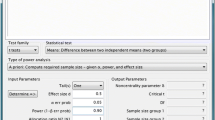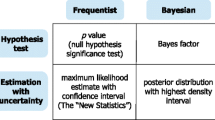Abstract
G*Power (Erdfelder, Faul, & Buchner, 1996) was designed as a general stand-alone power analysis program for statistical tests commonly used in social and behavioral research. G*Power 3 is a major extension of, and improvement over, the previous versions. It runs on widely used computer platforms (i.e., Windows XP, Windows Vista, and Mac OS X 10.4) and covers many different statistical tests of thet, F, and χ2 test families. In addition, it includes power analyses forz tests and some exact tests. G*Power 3 provides improved effect size calculators and graphic options, supports both distribution-based and design-based input modes, and offers all types of power analyses in which users might be interested. Like its predecessors, G*Power 3 is free.
Article PDF
Similar content being viewed by others
Avoid common mistakes on your manuscript.
References
Akkad, D. A., Jagiello, P., Szyld, P., Goedde, R., Wieczorek, S., Gross, W. L., &Epplen, J. T. (2006). Promoter polymorphism rs3087456 in the MHC class II transactivator gene is not associated with susceptibility for selected autoimmune diseases in German patient groups.International Journal of Immunogenetics,33, 59–61.
Back, M. D., Schmukle, S. C., &Egloff, B. (2005). Measuring taskswitching ability in the Implicit Association Test.Experimental Psychology,52, 167–179.
Baeza, J. A., &Stotz, W. (2003). Host-use and selection of differently colored sea anemones by the symbiotic crabAllopetrolisthes spinifrons.Journal of Experimental Marine Biology & Ecology,284, 25–39.
Barabesi, L., &Greco, L. (2002). A note on the exact computation of the Student t, Snedecor F, and sample correlation coefficient distribution functions.Journal of the Royal Statistical Society,51D, 105–110.
Berti, S., Münzer, S., Schröger, E., &Pechmann, T. (2006). Different interference effects in musicians and a control group.Experimental Psychology,53, 111–116.
Bradley, D. R., Russell, R. L., &Reeve, C. P. (1998). The accuracy of four approximations to noncentralF. Behavior Research Methods, Instruments, & Computers,30, 478–500.
Bredenkamp, J. (1969). Über die Anwendung von Signifikanztests bei Theorie-testenden Experimenten [The application of significance tests in theory-testing experiments].Psychologische Beiträge,11, 275–285.
Bredenkamp, J., &Erdfelder, E. (1985). Multivariate Varianzanalyse nach dem V-Kriterium [Multivariate analysis of variance based on the V-criterion].Psychologische Beiträge,27, 127–154.
Buchner, A., Erdfelder, E., &Faul, F. (1996). Teststärkeanalysen [Power analyses]. In E. Erdfelder, R. Mausfeld, T. Meiser, & G. Rudinger (Eds.),Handbuch Quantitative Methoden [Handbook of quantitative methods] (pp. 123–136). Weinheim, Germany: Psychologie Verlags Union.
Buchner, A., Erdfelder, E., & Faul, F. (1997). How to use G*Power [Computer manual]. Available at www.psycho.uni-duesseldorf.de/aap/projects/gpower/how_to_use_gpower.html.
Busbey, A. B. I. (1999). Macintosh shareware/freeware earthscience software.Computers & Geosciences,25, 335–340.
Cohen, J. (1988).Statistical power analysis for the behavioral sciences (2nd ed.). Hillsdale, NJ: Erlbaum.
D’Agostino, R. B., Chase, W., &Belanger, A. (1988). The appropriateness of some common procedures for testing the equality of two independent binomial populations.American Statistician,42, 198–202.
Erdfelder, E. (1984). Zur Bedeutung und Kontrolle desb-Fehlers bei der inferenzstatistischen Prüfung log-linearer Modelle [Significance and control of theb error in statistical tests of log-linear models].Zeitschrift für Sozialpsychologie,15, 18–32.
Erdfelder, E., Buchner, A., Faul, F., &Brandt, M. (2004). GPOWER: Teststärkeanalysen leicht gemacht [Power analyses made easy]. In E. Erdfelder & J. Funke (Eds.),Allgemeine Psychologie und deduktivistische Methodologie [Experimental psychology and deductive methodology] (pp. 148–166). Göttingen: Vandenhoeck & Ruprecht.
Erdfelder, E., Faul, F., &Buchner, A. (1996). GPOWER: A general power analysis program.Behavior Research Methods, Instruments, & Computers,28, 1–11.
Erdfelder, E., Faul, F., &Buchner, A. (2005). Power analysis for categorical methods. In B. S. Everitt & D. C. Howell (Eds.),Encyclopedia of statistics in behavioral science (pp. 1565–1570). Chichester, U.K.: Wiley.
Farrington, C. P., &Manning, G. (1990). Test statistics and sample size formulae for comparative binomial trials with null hypothesis of non-zero risk difference or non-unity relative risk.Statistics in Medicine,9, 1447–1454.
Field, A. P. (2005).Discovering statistics with SPSS (2nd ed.). London: Sage.
Fleiss, J. L. (1981).Statistical methods for rates and proportions (2nd ed.). New York: Wiley.
Frings, C., &Wentura, D. (2005). Negative priming with masked distractor-only prime trials: Awareness moderates negative priming.Experimental Psychology,52, 131–139.
Gart, J. J., &Nam, J. (1988). Approximate interval estimation of the ratio in binomial parameters: A review and correction for skewness.Biometrics,44, 323–338.
Gart, J. J., &Nam, J. (1990). Approximate interval estimation of the difference in binomial parameters: Correction for skewness and extension to multiple tables.Biometrics,46, 637–643.
Geisser, S., &Greenhouse, S. W. (1958). An extension of Box’s results on the use of theF distribution in multivariate analysis.Annals of Mathematical Statistics,29, 885–891.
Gerard, P. D., Smith, D. R., &Weerakkody, G. (1998). Limits of retrospective power analysis.Journal of Wildlife Management,62, 801–807.
Gigerenzer, G., Krauss, S., &Vitouch, O. (2004). The null ritual: What you always wanted to know about significance testing but were afraid to ask. In D. Kaplan (Ed.),The SAGE handbook of quantitative methodology for the social sciences (pp. 391–408). Thousand Oaks, CA: Sage.
Gleissner, U., Clusmann, H., Sassen, R., Elger, C. E., &Helmstaedter, C. (2006). Postsurgical outcome in pediatric patients with epilepsy: A comparison of patients with intellectual disabilities, subaverage intelligence, and average-range intelligence.Epilepsia,47, 406–414.
Goldstein, R. (1989). Power and sample size via MS/PC-DOS computers.American Statistician,43, 253–262.
Hager, W. (2006). Die Fallibilität empirischer Daten und die Notwendigkeit der Kontrolle von falschen Entscheidungen [The fallibility of empirical data and the need for controlling for false decisions].Zeitschrift für Psychologie,214, 10–23.
Haseman, J. K. (1978). Exact sample sizes for use with the Fisher—Irwin test for 2 × 2 tables.Biometrics,34, 106–109.
Hoenig, J. N., &Heisey, D. M. (2001). The abuse of power: The pervasive fallacy of power calculations for data analysis.American Statistician,55, 19–24.
Hoffmann, J., &Sebald, A. (2005). Local contextual cuing in visual search.Experimental Psychology,52, 31–38.
Huynh, H., &Feldt, L. S. (1970). Conditions under which mean square ratios in repeated measurements designs have exactF-distribution.Journal of the American Statistical Association,65, 1582–1589.
Keppel, G., &Wickens, T. D. (2004).Design and analysis. A researcher’s handbook (4th ed.). Upper Saddle River, NJ: Pearson Education International.
Kornbrot, D. E. (1997). Review of statistical shareware G*Power.British Journal of Mathematical & Statistical Psychology,50, 369–370.
Kromrey, J., &Hogarty, K. Y. (2000). Problems with probabilistic hindsight: A comparison of methods for retrospective statistical power analysis.Multiple Linear Regression Viewpoints,26, 7–14.
Lenth, R. V. (2001). Some practical guidelines for effective sample size determination.American Statistician,55, 187–193.
Levin, J. R. (1997). Overcoming feelings of powerlessness in “aging” researches: A primer on statistical power in analysis of variance designs.Psychology & Aging,12, 84–106.
McKeon, J. J. (1974).F approximations to the distribution of Hotelling’sT02.Biometrika,61, 381–383.
Mellina, E., Hinch, S. G., Donaldson, E. M., &Pearson, G. (2005). Stream habitat and rainbow trout (Oncorhynchus mykiss) physiological stress responses to streamside clear-cut logging in British Columbia.Canadian Journal of Forest Research,35, 541–556.
Miettinen, O., &Nurminen, M. (1985). Comparative analysis of two rates.Statistics in Medicine,4, 213–226.
Müller, J., Manz, R., &Hoyer, J. (2002). Was tun, wenn die Teststärke zu gering ist? Eine praktikable Strategie für Prä-Post-Designs [What to do if statistical power is low? A practical strategy for prepost-designs].Psychotherapie, Psychosomatik, Medizinische Psychologie,52, 408–416.
Muller, K. E., &Barton, C. N. (1989). Approximate power for repeatedmeasures ANOVA lacking sphericity.Journal of the American Statistical Association,84, 549–555.
Muller, K. E., LaVange, L. M., Landesman-Ramey, S., &Ramey, C. T. (1992). Power calculations for general linear multivariate models including repeated measures applications.Journal of the American Statistical Association,87, 1209–1226.
Muller, K. E., &Peterson, B. L. (1984). Practical methods for computing power in testing the multivariate general linear hypothesis.Computational Statistics & Data Analysis,2, 143–158.
Myers, J. L., &Well, A. D. (2003).Research design and statistical analysis (2nd ed.). Mahwah, NJ: Erlbaum.
O’Brien, R. G., &Kaiser, M. K. (1985). MANOVA method for analyzing repeated measures designs: An extensive primer.Psychological Bulletin,97, 316–333.
O’Brien, R. G., &Muller, K. E. (1993). Unified power analysis fort-tests through multivariate hypotheses. In L. K. Edwards (Ed.),Applied analysis of variance in behavioral science (pp. 297–344). New York: Dekker.
O’Brien, R. G., & Shieh, G. (1999).Pragmatic, unifying algorithm gives power probabilities for common F tests of the multivariate general linear hypothesis. Available at www.bio.ri.ccf.org/UnifyPow.
Ortseifen, C., Bruckner, T., Burke, M., &Kieser, M. (1997). An overview of software tools for sample size determination.Informatik, Biometrie & Epidemiologie in Medizin & Biologie,28, 91–118.
Ostle, B., &Malone, L. C. (1988).Statistics in research: Basic concepts and techniques for research workers (4th ed.). Ames: Iowa State Press.
Pillai, K. C. S., &Mijares, T. A. (1959). On the moments of the trace of a matrix and approximations to its distribution.Annals of Mathematical Statistics,30, 1135–1140.
Pillai, K. C. S., &Samson, P., Jr. (1959). On Hotelling’s generalization ofT2.Biometrika,46, 160–168.
Quednow, B. B., Kühn, K.-U., Stelzenmueller, R., Hoenig, K., Maier, W., &Wagner, M. (2004). Effects of serotonergic and noradrenergic antidepressants on auditory startle response in patients with major depression.Psychopharmacology,175, 399–406.
Rao, C. R. (1951). An asymptotic expansion of the distribution of Wilks’s criterion.Bulletin of the International Statistical Institute,33, 177–180.
Rasch, B., Friese, M., Hofmann, W. J., &Naumann, E. (2006a).Quantitative Methoden 1: Einführung in die Statistik (2. Auflage) [Quantitative methods 1: Introduction to statistics (2nd ed.)]. Heidelberg, Germany: Springer.
Rasch, B., Friese, M., Hofmann, W. J., &Naumann, E. (2006b).Quantitative Methoden 2: Einführung in die Statistik (2. Auflage) [Quantitative methods 2: Introduction to statistics (2nd ed.)]. Heidelberg, Germany: Springer.
Rencher, A. C. (1998).Multivariate statistical inference and applications. New York: Wiley.
Richardson, J. T. E. (1996). Measures of effect size.Behavior Research Methods, Instruments, & Computers,28, 12–22.
Scheffé, H. (1959).The analysis of variance. New York: Wiley.
Schwarz, W., &Müller, D. (2006). Spatial associations in numberrelated tasks: A comparison of manual and pedal responses.Experimental Psychology,53, 4–15.
Sheppard, C. (1999). How large should my sample be? Some quick guides to sample size and the power of tests.Marine Pollution Bulletin,38, 439–447.
Shieh, G. (2003). A comparative study of power and sample size calculations for multivariate general linear models.Multivariate Behavioral Research,38, 285–307.
Smith, R. E., &Bayen, U. J. (2005). The effects of working memory resource availability on prospective memory: A formal modeling approach.Experimental Psychology,52, 243–256.
Steidl, R. J., Hayes, J. P., &Schauber, E. (1997). Statistical power analysis in wildlife research.Journal of Wildlife Management,61, 270–279.
Suissa, S., &Shuster, J. J. (1985). Exact unconditional sample sizes for 2 × 2 binomial trial.Journal of the Royal Statistical Society A,148, 317–327.
Thomas, L., &Krebs, C. J. (1997). A review of statistical power analysis software.Bulletin of the Ecological Society of America,78, 126–139.
Upton, G. J. G. (1982). A comparison of alternative tests for the 2 3 2 comparative trial.Journal of the Royal Statistical Society A,145, 86–105.
Westermann, R., &Hager, W. (1986). Error probabilities in educational and psychological research.Journal of Educational Statistics,11, 117–146.
Zumbo, B. D., &Hubley, A. M. (1998). A note on misconceptions concerning prospective and retrospective power.The Statistician,47, 385–388.
Author information
Authors and Affiliations
Corresponding authors
Additional information
Manuscript preparation was supported by Grant SFB 504 (Project A12) from the Deutsche Forschungsgemeinschaft and a grant from the state of Baden-Württemberg, Germany (Landesforschungsprogramm „Evidenzbasierte Stressprävention”).
Rights and permissions
About this article
Cite this article
Faul, F., Erdfelder, E., Lang, AG. et al. G*Power 3: A flexible statistical power analysis program for the social, behavioral, and biomedical sciences. Behavior Research Methods 39, 175–191 (2007). https://doi.org/10.3758/BF03193146
Received:
Accepted:
Issue Date:
DOI: https://doi.org/10.3758/BF03193146




